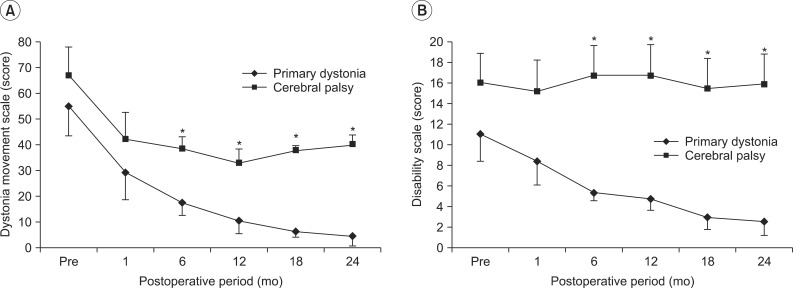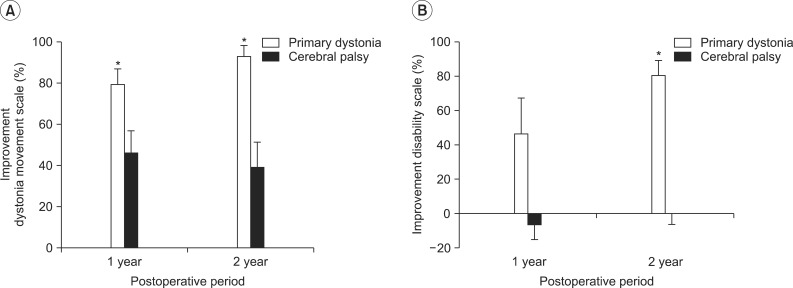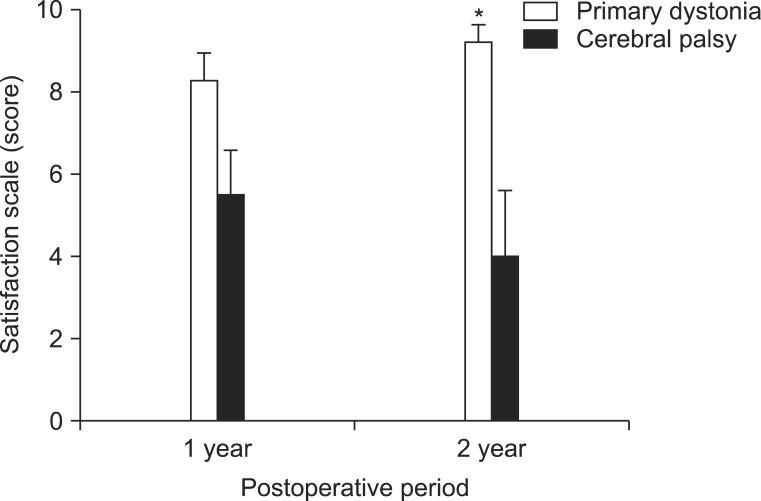Ann Rehabil Med.
2014 Apr;38(2):209-217.
Two-Year Outcomes of Deep Brain Stimulation in Adults With Cerebral Palsy
- Affiliations
-
- 1Department of Rehabilitation Medicine and Research Institute of Rehabilitation Medicine, Yonsei University College of Medicine, Seoul, Korea. srcho918@yuhs.ac
- 2Department of Neurosurgery and Brain Research Institute, Yonsei University College of Medicine, Seoul, Korea.
- 3Brain Korea 21 PLUS Project for Medical Science, Yonsei University College of Medicine, Seoul, Korea.
- 4Graduate School Program of Nano Science and Technology, Yonsei University, Seoul, Korea.
- 5Avison Biomedical Research Center, Yonsei University College of Medicine, Seoul, Korea.
Abstract
OBJECTIVE
To investigate the effect of deep brain stimulation (DBS) on reducing dystonia and disability in adults with cerebral palsy (CP) and to compare the therapeutic outcomes between primary dystonia patients and CP patients over two years after bilateral pallidal DBS.
METHODS
Five patients with primary dystonia and seven CP patients with dystonia were recruited. All subjects received DBS surgery in both globus pallidus. Burke-Fahn-Marsden dystonia rating scale consisting of dystonia movement score and disability score and subjective satisfaction scale were assessed after 1 month and every 6 months over two years following DBS treatment.
RESULTS
On the dystonia movement scale, both groups of primary dystonia patients and CP patients showed a significant decrease over time following DBS. On the disability scale, patients with primary dystonia showed a significant decrease over time, whereas the disability score of CP patients did not change over the two years. Comparing the dystonia movement and disability scores of CP patients at each assessment, patients with primary dystonia showed a significant reduction after 6 months. Comparing the satisfaction scores of CP patients after DBS, patients with primary dystonia showed significantly higher subjective satisfaction.
CONCLUSION
Whereas dystonia can be significantly reduced in patients with primary dystonia, CP patients showed a modest improvement on the dystonia movement scale, but not on the disability scale. Therefore, DBS may be considered with caution as a treatment modality of CP patients with dystonia.
MeSH Terms
Figure
Reference
-
1. Bhidayasiri R. Dystonia: genetics and treatment update. Neurologist. 2006; 12:74–85. PMID: 16534444.2. Fahn S. Concept and classification of dystonia. Adv Neurol. 1988; 50:1–8. PMID: 3041755.3. Hartmann A, Pogarell O, Oertel WH. Secondary dystonias. J Neurol. 1998; 245:511–518. PMID: 9747914.
Article4. Jankovic J. Dystonia: medical therapy and botulinum toxin. Adv Neurol. 2004; 94:275–286. PMID: 14509685.5. Gilderberg PL, Tasker RR. Textbook of stereotactic and functional neurosurgery. 1st ed. New York: Springer;1998.6. Ostrem JL, Starr PA. Treatment of dystonia with deep brain stimulation. Neurotherapeutics. 2008; 5:320–330. PMID: 18394573.
Article7. DeLong M, Wichmann T. Deep brain stimulation for movement and other neurologic disorders. Ann N Y Acad Sci. 2012; 1265:1–8. PMID: 22823512.
Article8. Benabid AL, Benazzouz A, Hoffmann D, Limousin P, Krack P, Pollak P. Long-term electrical inhibition of deep brain targets in movement disorders. Mov Disord. 1998; 13(Suppl 3):119–125. PMID: 9827607.
Article9. Benazzouz A, Breit S, Koudsie A, Pollak P, Krack P, Benabid AL. Intraoperative microrecordings of the subthalamic nucleus in Parkinson's disease. Mov Disord. 2002; 17(Suppl 3):S145–S149. PMID: 11948769.
Article10. Olanow CW, Brin MF, Obeso JA. The role of deep brain stimulation as a surgical treatment for Parkinson's disease. Neurology. 2000; 55(12 Suppl 6):S60–S66. PMID: 11188977.11. Vercueil L, Krack P, Pollak P. Results of deep brain stimulation for dystonia: a critical reappraisal. Mov Disord. 2002; 17(Suppl 3):S89–S93. PMID: 11948761.
Article12. Eltahawy HA, Saint-Cyr J, Giladi N, Lang AE, Lozano AM. Primary dystonia is more responsive than secondary dystonia to pallidal interventions: outcome after pallidotomy or pallidal deep brain stimulation. Neurosurgery. 2004; 54:613–619. PMID: 15028135.
Article13. Vidailhet M, Yelnik J, Lagrange C, Fraix V, Grabli D, Thobois S, et al. Bilateral pallidal deep brain stimulation for the treatment of patients with dystonia-choreoathetosis cerebral palsy: a prospective pilot study. Lancet Neurol. 2009; 8:709–717. PMID: 19576854.
Article14. Pretto TE, Dalvi A, Kang UJ, Penn RD. A prospective blinded evaluation of deep brain stimulation for the treatment of secondary dystonia and primary torticollis syndromes. J Neurosurg. 2008; 109:405–409. PMID: 18759568.
Article15. Zhang JG, Zhang K, Wang ZC, Ge M, Ma Y. Deep brain stimulation in the treatment of secondary dystonia. Chin Med J (Engl). 2006; 119:2069–2074. PMID: 17199958.
Article16. Katsakiori PF, Kefalopoulou Z, Markaki E, Paschali A, Ellul J, Kagadis GC, et al. Deep brain stimulation for secondary dystonia: results in 8 patients. Acta Neurochir (Wien). 2009; 151:473–478. PMID: 19322514.
Article17. Hardesty DE, Sackeim HA. Deep brain stimulation in movement and psychiatric disorders. Biol Psychiatry. 2007; 61:831–835. PMID: 17126303.
Article18. Kopell BH, Greenberg B, Rezai AR. Deep brain stimulation for psychiatric disorders. J Clin Neurophysiol. 2004; 21:51–67. PMID: 15097294.
Article19. Yu H, Neimat JS. The treatment of movement disorders by deep brain stimulation. Neurotherapeutics. 2008; 5:26–36. PMID: 18164481.
Article20. Krauss JK, Yianni J, Loher TJ, Aziz TZ. Deep brain stimulation for dystonia. J Clin Neurophysiol. 2004; 21:18–30. PMID: 15097291.
Article21. Tagliati M, Shils J, Sun C, Alterman R. Deep brain stimulation for dystonia. Expert Rev Med Devices. 2004; 1:33–41. PMID: 16293008.
Article22. Krack P, Pollak P, Limousin P, Benazzouz A, Deuschl G, Benabid AL. From off-period dystonia to peak-dose chorea: the clinical spectrum of varying subthalamic nucleus activity. Brain. 1999; 122(Pt 6):1133–1146. PMID: 10356065.
Article23. Kupsch A, Earl C. Neurosurgical interventions in the treatment of idiopathic Parkinson disease: neurostimulation and neural implantation. J Mol Med (Berl). 1999; 77:178–184. PMID: 9930959.
Article24. Tisch S, Rothwell JC, Limousin P, Hariz MI, Corcos DM. The physiological effects of pallidal deep brain stimulation in dystonia. IEEE Trans Neural Syst Rehabil Eng. 2007; 15:166–172. PMID: 17601185.
Article25. Kim JP, Chang WS, Park YS, Chang JW. Bilateral globus pallidus internus deep brain stimulation for DYT1+ generalized dystonia with previously received bilateral thalamotomy and unilateral pallidotomy. Stereotact Funct Neurosurg. 2011; 89:205–209. PMID: 21597310.
Article
- Full Text Links
- Actions
-
Cited
- CITED
-
- Close
- Share
- Similar articles
-
- Combined Therapy of Orthopedic Surgery after Deep Brain Stimulation in Cerebral Palsy Mixed Type: A Case Report
- Outcomes of Intrathecal Baclofen Therapy Compared With Deep Brain Stimulation in a Patient With Dystonic Cerebral Palsy: A Case Report
- Deep Brain Stimulation for the Treatment of Movement Disorders
- Malignant Neuroleptic Syndrome following Deep Brain Stimulation Surgery of Globus Pallidus Pars Internus in Cerebral Palsy
- Theoretical considerations of deep brain stimulation programming




